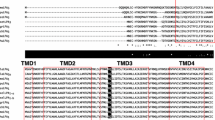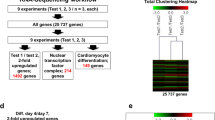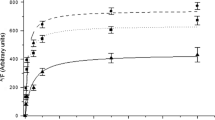Abstract
Lysophospholipids (LPs) are small signaling lipids that regulate diverse physiological and pathological processes through G protein-coupled receptors. To investigate the function of LP signaling in heart organogenesis and maturation, we measured the expression of 10 confirmed LP receptors (Lpar1–5 and S1pr1–5) in rat heart from embryonic day 19.5 (E19.5d) to postnatal week 12 (P12w). The expression of Lpar3 mRNA peaked at 37-fold higher than adult expression at P1d, while the expression levels of Lpar1 and Lpar4 increased markedly after P1d and peaked at 19- and 48-folds of adult expression on P7d. The expression levels of all three receptor mRNAs were significantly reduced by P21d and remained low thereafter. Expression of the corresponding receptor proteins also peaked during the early postnatal period but the subsequent decline was less dramatic from P14d to P12w compared to mRNA expression. In contrast, S1pr1 and S1pr3 exhibited more gradual developmental changes. Although early expression was higher than mature expression (3- to 6-fold), these receptors were still strongly expressed at P12w. The other isotypes examined, Lpar2, Lpar5, S1pr4, and S1pr5, were very weakly expressed at all developmental stages. Analysis of receptor distribution within the developing heart (P1d) revealed that Lpar1, Lpar3, and Lpar4 were expressed in the myocardium of all four chambers but not in valves, while Lpar3 was also uniquely expressed in the aorta and coronary vessels. Western blots revealed that the developmental changes in Lpar1, Lpar3, and Lpar4 protein expression mirrored changes in β-actin and β-tubulin expression. The increase in Lpar1 and Lpar4 receptors from P1d to P7d corresponds to the period of rapid myocardial growth and functional maturation. Moreover, the relatively high expression of Lpar1, Lpar3, and Lpar4 in the late prenatal rat heart suggests that these LPA receptors may also contribute to organogenesis. The increase in Lpar3 and Lpar4 expression concomitant with rising expression of cytoskeleton proteins further suggests a possible role for LPA signaling in cytoskeletal remodeling during cardiac development.







Similar content being viewed by others
References
Rivera R, Chun J (2008) Biological effects of lysophospholipids. Rev Physiol Biochem Pharmacol 160:25–46. doi:10.1007/112_0507
Yanagida K, Masago K, Nakanishi H, Kihara Y, Hamano F, Tajima Y, Taguchi R, Shimizu T, Ishii S (2009) Identification and characterization of a novel lysophosphatidic acid receptor, p2y5/LPA6. J Biol Chem 284(26):17731–17741. doi:10.1074/jbc.M808506200
Tabata K, Baba K, Shiraishi A, Ito M, Fujita N (2007) The orphan GPCR GPR87 was deorphanized and shown to be a lysophosphatidic acid receptor. Biochem Biophys Res Commun 363(3):861–866. doi:10.1016/j.bbrc.2007.09.063
Murakami M, Shiraishi A, Tabata K, Fujita N (2008) Identification of the orphan GPCR, P2Y(10) receptor as the sphingosine-1-phosphate and lysophosphatidic acid receptor. Biochem Biophys Res Commun 371(4):707–712. doi:10.1016/j.bbrc.2008.04.145
Choi JW, Herr DR, Noguchi K, Yung YC, Lee CW, Mutoh T, Lin ME, Teo ST, Park KE, Mosley AN, Chun J (2010) LPA receptors: subtypes and biological actions. Annu Rev Pharmacol Toxicol 50:157–186. doi:10.1146/annurev.pharmtox.010909.105753
Liu Y, Wada R, Yamashita T, Mi Y, Deng CX, Hobson JP, Rosenfeldt HM, Nava VE, Chae SS, Lee MJ, Liu CH, Hla T, Spiegel S, Proia RL (2000) Edg-1, the G protein-coupled receptor for sphingosine-1-phosphate, is essential for vascular maturation. J Clin Invest 106(8):951–961. doi:10.1172/JCI10905
MacLennan AJ, Benner SJ, Andringa A, Chaves AH, Rosing JL, Vesey R, Karpman AM, Cronier SA, Lee N, Erway LC, Miller ML (2006) The S1P2 sphingosine 1-phosphate receptor is essential for auditory and vestibular function. Hear Res 220(1–2):38–48. doi:10.1016/j.heares.2006.06.016
Kupperman E, An S, Osborne N, Waldron S, Stainier DY (2000) A sphingosine-1-phosphate receptor regulates cell migration during vertebrate heart development. Nature 406(6792):192–195. doi:10.1038/35018092
Ohuchi H, Hamada A, Matsuda H, Takagi A, Tanaka M, Aoki J, Arai H, Noji S (2008) Expression patterns of the lysophospholipid receptor genes during mouse early development. Dev Dyn 237(11):3280–3294. doi:10.1002/dvdy.21736
Siess W, Zangl KJ, Essler M, Bauer M, Brandl R, Corrinth C, Bittman R, Tigyi G, Aepfelbacher M (1999) Lysophosphatidic acid mediates the rapid activation of platelets and endothelial cells by mildly oxidized low density lipoprotein and accumulates in human atherosclerotic lesions. Proc Natl Acad Sci USA 96(12):6931–6936
Chen J, Han Y, Zhu W, Ma R, Han B, Cong X, Hu S, Chen X (2006) Specific receptor subtype mediation of LPA-induced dual effects in cardiac fibroblasts. FEBS Lett 580(19):4737–4745. doi:10.1016/j.febslet.2006.07.061
Theilmeier G, Schmidt C, Herrmann J, Keul P, Schafers M, Herrgott I, Mersmann J, Larmann J, Hermann S, Stypmann J, Schober O, Hildebrand R, Schulz R, Heusch G, Haude M, von Wnuck Lipinski K, Herzog C, Schmitz M, Erbel R, Chun J, Levkau B (2006) High-density lipoproteins and their constituent, sphingosine-1-phosphate, directly protect the heart against ischemia/reperfusion injury in vivo via the S1P3 lysophospholipid receptor. Circulation 114(13):1403–1409. doi:10.1161/CIRCULATIONAHA.105.607135
Chen J, Chen Y, Zhu W, Han Y, Han B, Xu R, Deng L, Cai Y, Cong X, Yang Y, Hu S, Chen X (2008) Specific LPA receptor subtype mediation of LPA-induced hypertrophy of cardiac myocytes and involvement of Akt and NFkappaB signal pathways. J Cell Biochem 103(6):1718–1731. doi:10.1002/jcb.21564
Anversa P, Ricci R, Olivetti G (1986) Quantitative structural analysis of the myocardium during physiologic growth and induced cardiac hypertrophy: a review. J Am Coll Cardiol 7(5):1140–1149
Anversa P, Olivetti G, Loud AV (1980) Morphometric study of early postnatal development in the left and right ventricular myocardium of the rat. I. Hypertrophy, hyperplasia, and binucleation of myocytes. Circ Res 46(4):495–502
Mills E, Smith PG (1986) Mechanisms of adrenergic control of blood pressure in developing rats. Am J Physiol 250(2 Pt 2):R188–R192
Li F, Wang X, Capasso JM, Gerdes AM (1996) Rapid transition of cardiac myocytes from hyperplasia to hypertrophy during postnatal development. J Mol Cell Cardiol 28(8):1737–1746. doi:10.1006/jmcc.1996.0163
Hopkins SF Jr, McCutcheon EP, Wekstein DR (1973) Postnatal changes in rat ventricular function. Circ Res 32(6):685–691
Wu Y, Wu EX (2009) MR study of postnatal development of myocardial structure and left ventricular function. J Magn Reson Imaging 30(1):47–53. doi:10.1002/jmri.21814
Smolich JJ (1995) Ultrastructural and functional features of the developing mammalian heart: a brief overview. Reprod Fertil Dev 7(3):451–461
Seki S (2003) Fetal and postnatal development of Ca2 + transients and Ca2 + sparks in rat cardiomyocytes. Cardiovasc Res 58(3):535–548. doi:10.1016/s0008-6363(03)00255-4
Contos JJ, Fukushima N, Weiner JA, Kaushal D, Chun J (2000) Requirement for the lpA1 lysophosphatidic acid receptor gene in normal suckling behavior. Proc Natl Acad Sci USA 97(24):13384–13389. doi:10.1073/pnas.97.24.13384
van Meeteren LA, Ruurs P, Stortelers C, Bouwman P, van Rooijen MA, Pradere JP, Pettit TR, Wakelam MJ, Saulnier-Blache JS, Mummery CL, Moolenaar WH, Jonkers J (2006) Autotaxin, a secreted lysophospholipase D, is essential for blood vessel formation during development. Mol Cell Biol 26(13):5015–5022. doi:10.1128/MCB.02419-05
Lloyd B, Tao Q, Lang S, Wylie C (2005) Lysophosphatidic acid signaling controls cortical actin assembly and cytoarchitecture in Xenopus embryos. Development 132(4):805–816. doi:10.1242/dev.01618
Bernhart E, Kollroser M, Rechberger G, Reicher H, Heinemann A, Schratl P, Hallstrom S, Wintersperger A, Nusshold C, DeVaney T, Zorn-Pauly K, Malli R, Graier W, Malle E, Sattler W (2010) Lysophosphatidic acid receptor activation affects the C13NJ microglia cell line proteome leading to alterations in glycolysis, motility, and cytoskeletal architecture. Proteomics 10(1):141–158. doi:10.1002/pmic.200900195
Acknowledgments
This work was supported by National Basic Research Program of China (2010CB529500) and National Natural Science Foundation of China (81170154).
Author information
Authors and Affiliations
Corresponding authors
Rights and permissions
About this article
Cite this article
Wang, F., Hou, J., Han, B. et al. Developmental changes in lysophospholipid receptor expression in rodent heart from near-term fetus to adult. Mol Biol Rep 39, 9075–9084 (2012). https://doi.org/10.1007/s11033-012-1778-6
Received:
Accepted:
Published:
Issue Date:
DOI: https://doi.org/10.1007/s11033-012-1778-6




